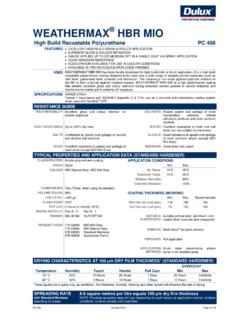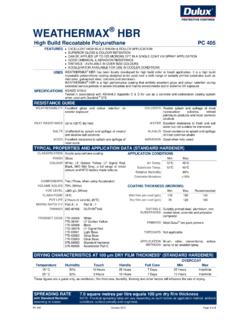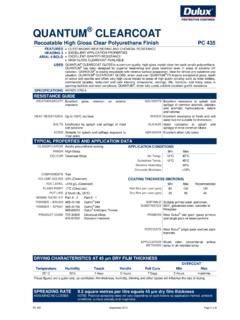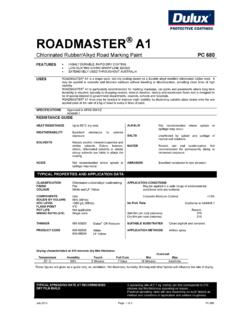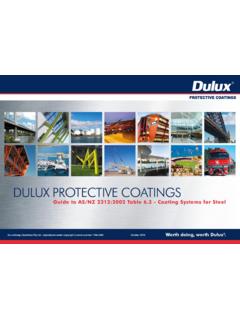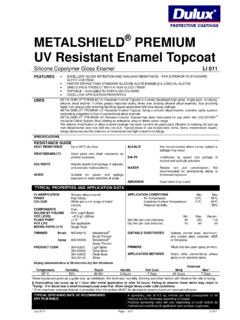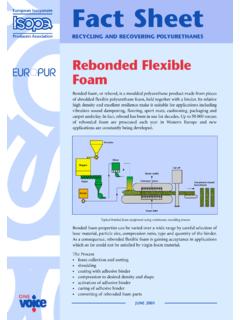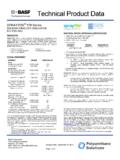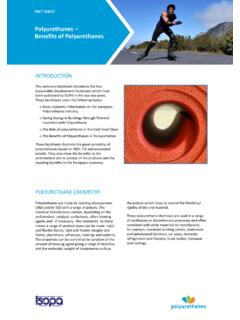Transcription of WHAT ARE ISOCYANATES? - Dulux Protective …
1 what ARE ISOCYANATES? A polyurethane resin is the result of the chemical reaction between a polyol resin (also known as Part A ) and a hardener or curing agent (also known as Part B ). The chemically reactive material in the hardener is called the poly- isocyanate curing agent, which becomes an integral part of the polyurethane polymer when mixed with the polyol resin. The poly- isocyanate curing agents commonly used in two pack coatings are made from various diisocyanate monomers. In the poly- isocyanate polymerisation process, less than remains as diisocyanate monomer. When made up into typical two-pack polyurethane coatings, this diisocyanate monomer generally represents less than i of the total formula.
2 Although present at very low levels, the diisocyanate monomer can pose health risks if the polyurethane paint is handled improperly. It is important to note that the risks associated with the diisocyanate monomer should be balanced with risks in using alternative curing agents, and with the application of any solvent-borne coating. If the user always followed their respective State Spray Painting Regulations (Qld, NSW, ACT, Vic, Tas, SA, WA & NT) and wore a well-fitting, positive-pressure, air-fed full-face respirator and overalls, safety shoes and solvent-resistant gloves, then they would not be at any risk at all. what ARE THE POTENTIAL HAZARDS? All chemicals have the potential to harm, if used incorrectly.
3 (Even nutritional supplements can cause severe toxic effects if misused!). However, if a polyurethane paint is handled in accordance with relevant Safety Data Sheets, product specifications, and State regulations no adverse health effects are expected. Symptoms or effects that may arise if there is uncontrolled exposure to the product or if it is mishandled are described on the Material Safety Data Sheet as follows: Ingestion: Swallowing can result in nausea, vomiting and central nervous system depression. If the affected person is showing signs of central system depression (like those of drunkeness) there is greater likelihood of that person breathing in vomit and causing damage to the lungs. Eye contact: May be an eye irritant.
4 Skin contact: Contact with skin may result in irritation. A skin sensitiser. Repeated or prolonged skin contact may lead to allergic contact dermatitis. Inhalation: Material may be an irritant to the mucous membranes of the respiratory tract (airways). Breathing in vapour can result in headaches, dizziness, drowsiness, and possible nausea. Inhaling high concentrations can produce central nervous system depression, which can lead to loss of co-ordination, impaired judgement and if exposure is prolonged, unconsciousness. Respiratory sensitiser. Can cause possible allergic reactions, producing asthma-like symptoms. Of the above forms of misuse, inhalation is the most likely point of entry into the body. BRUSH AND ROLLER APPLICATION.
5 Neither poly- isocyanate curing agent nor diisocyanate monomer evaporates to any great extent from the polyurethane paint and therefore does not present an inhalation hazard under normal brush and roller application conditions. For more information on solvents, . please refer to Dulux PC Tech Note - Solvents. ii Comparing the vapour pressure of the poly- isocyanate curing agent and the diisocyanate monomer with solvents (including water) puts iii the relative risk of inhalation of each into perspective . Application of polyurethane by brush or roller exposes the applicator to risk of splash and spillage of wet paint onto unprotected areas of the body only, and not to any appreciable amounts of airborne material other than vapour which has evaporated out of the wet paint Therefore, the major risks of brush and roller application include contact with skin and eyes and inhalation of vapour.
6 RELATIVE. CHEMICAL VAPOUR PRESSURE VAPOUR. PRESSURE. (MM HG AT 25 C) (WATER = 1). Poly- isocyanate Hexamethylene Di isocyanate Xylene 8 Water 18 1. MEK 91 The table above shows that the evaporation rate of MEK is five times that of water; xylene is less than half that of water. Both the poly- isocyanate curing agent and diisocyanate monomer have extremely low vapour pressures, and as these represent only a small fraction of the composition of polyurethane paint, it is likely that an applicator neglecting to wear a solvent-filter mask, will be exposed to solvent vapours, and virtually zero levels of poly- isocyanate curing agent or diisocyanate monomer under normal circumstances. To take a particular example of a high solids polyurethane the table below shows the relative levels of solvent and diisocyanate (in this case hexamethylene diisocyanate, HDI) and then compares the vapour pressure of these components and also shows the Occupational Exposure Limits (OEL, the maximum continuous exposure level allowable over an eight hour shift) for each of these components.
7 2. Mass per m of Vapour Material OEL. applied topcoat Pressure (g) (kPa) (mg/m3). HDI * *. Solvents 100 480. *ex - Bayer MaterialScience AG material safety data sheet. The available HDI in this case is three orders of magnitude ( one thousand times) less than the available solvents. The vapour pressure for the HDI is also approximately three orders of magnitude less than that of the solvents. As the concentration in the air is going to be a product of the available material times its vapour pressure it can be seen that in normal circumstances the solvents will reach their OEL well before the HDI reaches its OEL. That is, it will be necessary to wear respiratory protection because of the solvents well before it would be required for the diisocyanate.
8 Of course in certain situations, such as confined or poorly ventilated spaces, the concentration of both solvent vapour and diisocyanate can exceed allowable exposure levels, so specific Protective equipment suitable for these circumstances must be used. When applying polyurethanes by brush or roller, the same precautions must be followed as for any solvent based paints these are: well-fitting, solvent-excluding face masks (to prevent inhalation of solvent vapour), and full Protective clothing such as solvent resistant gloves, safety boots, long sleeved tops and overalls (to prevent contact of paint with skin). The exposure risk when applying these coatings by spray is quite different from brush and roller application and so the precautions required for spraying these products are controlled by your specific state regulations.
9 SPRAY APPLICATION. Like all paints, waterborne and solvent borne - including polyurethanes - the health risks associated with inhalation increase when the paint is applied by spray. The spray gun creates a mist of paint droplets that are small enough to be air-borne and therefore easily inhaled during application. Given that the relative proportion of diisocyanate monomer in a droplet is significantly smaller than that of the solvent and solid particle components, it is fair to say that adverse effects arising from spray mist inhalation will be a combination of those from the isocyanate monomer, solvent vapours, pigment particles and other components. In fact it is important to note that, while there are specific health effects associated with the inhalation of poly- isocyanates and diisocyanate monomers which have been previously described, the inhalation of a spray mist from any kind of paint system, including water-borne paints, can have adverse health effects and should be avoided.
10 All respirable particles present inhalation hazards. Even the following common air-borne solids can trigger severe allergic reactions: Pollen Mould Spores Room Deodorisers Perfumes Saw Dust Hay Animal Fur Certain Food Odours Dust Mites This is not intended to trivialise the very real risks associated with isocyanates or any other spray applied product, but to put these risks into perspective. what ABOUT isocyanate -FREE COATINGS? Alternative two-pack technologies use other curing agents. Whilst they are isocyanate -free , that does not necessarily mean that they are less hazardous than polyurethanes. In fact, amine-adduct curing agents (the curing agent in epoxies) can produce similar symptoms and effects as isocyanates (if similarly misused).

